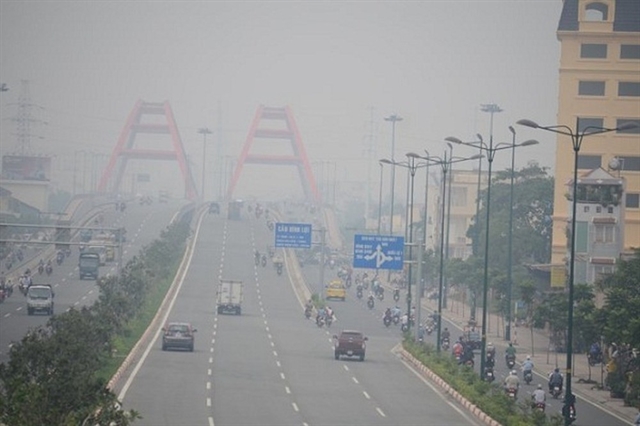 Environment
Environment

HCM City authorities have promised to take swift action to curb the worsening air pollution, including improving environmental monitoring capacity and establishing an early warning system for residents.

|
| Photochemical smog, a common phenomenon near traffic hot spots in HCM City, occurs cyclically. — Photo baomoi.com |
HCM CITY — HCM City authorities have promised to take swift action to curb the worsening air pollution, including improving environmental monitoring capacity and establishing an early warning system for residents.
Cao Tung Sơn, director of the HCM City Department of Natural Resources and Environment’s Centre for Environmental and Natural Resources Monitoring, said the city was calling for investment in 11 additional air-monitoring stations by 2030.
The city also plans to speed up current projects to build nine automatic air-monitoring stations and one mobile station to enhance environmental monitoring capacity.
It will enhance application of high-tech to manage the environmental monitoring network, especially the air environmental network.
“The city will develop specialised software that will provide early warnings about air pollution to residents on a daily basis via the media or smartphones,” he said.
The city will strictly oversee and enforce the laws on environmental protection and punish violations by production, service and business establishments, industrial parks and industrial complexes.
It will also implement measures to reduce traffic congestion and pollution caused by vehicles, according to Sơn, who spoke at a press conference held in HCM City on Wednesday.
In recent weeks, photochemical smog, which is harmful to human health, became worse in major cities such as Hà Nội and HCM City, according to local media.
Photochemical smog is a common phenomenon in traffic hot spots in HCM City where the level of air pollution exceeds the permissible limit, according to the centre.
Currently, the department is implementing air quality monitoring at 30 monitoring locations for a 10-day period each month from 7:30am to 8:30pm and from 3pm to 4pm.
The concentration of pollutants observed at 30 monitoring locations in the first nine months of this year has increased significantly compared to the same period last year, according to the centre.
According to a report from the centre, in the first nine months, the concentration of air pollution has exceeded the permitted level in major traffic points in HCM City, especially in recent days, such as Cát Lái, Huỳnh Tấn Phát-Nguyễn Văn Linh, Gò Vấp, An Sương and Bình Phước crossroad stations.
The most polluted area is the Cát Lái Station at Mỹ Thủy roundabout in District 2 where dust concentration has exceeded 99 per cent and noise levels have exceeded 100 per cent against the permissible level.
Smoke from cars and motorcycles caught in traffic is one of the major causes of air pollution, according to Sơn.
Recommendations
Experts have recommended that HCM City diversify investment in energy production, shifting to cleaner sources such as solar energy and energy-saving equipment.
The economic losses due to early deaths caused by air pollution were equivalent to 5-7 per cent of Việt Nam’s GDP last year, or US$11.4-15.9 billion, with at least 40,000 people dying of diseases related to pollution.
The number of deaths caused by air pollution is four times the number due to traffic accidents, which is around 11,000 a year.
It is estimated that the number of deaths each year due to air pollution will rise to over 100,000 by 2035, experts said.
According to the World Health Organisation (WHO), air pollution is considered “a silent killer” in Việt Nam.
According to statistics from WHO, air pollution is one of the highest causes of death in the world with around eight million people dying each year.
WHO data also shows that six out of the 10 diseases with the highest mortality rates in Việt Nam are related to air pollution.
Việt Nam’s urban areas have various types of pollutants far exceeding permissible limits, especially major urban areas like HCM City and Hà Nội, according to the Ministry of Natural Resources and Environment.
Warnings
The HCM City Department of Natural Resources and Environment recommends that people, especially children, the elderly, pregnant women and those with respiratory diseases, limit outdoor activities due to rising pollution, and use masks and glasses to cover the face and eyes when going out.
The agency has warned that levels of PM2.5, a particle with a diameter of less than 2.5 micrometres, could continue to remain high, especially at midnight and in early morning in the city.
The phenomenon occurs due to dry sunny weather during the day and low surface air temperatures at night.
Photochemical smog is caused by the interaction of solar ultraviolet radiation, engine exhaust emissions and industrial emissions, which means it is most prevalent in populated urban areas. — VNS




